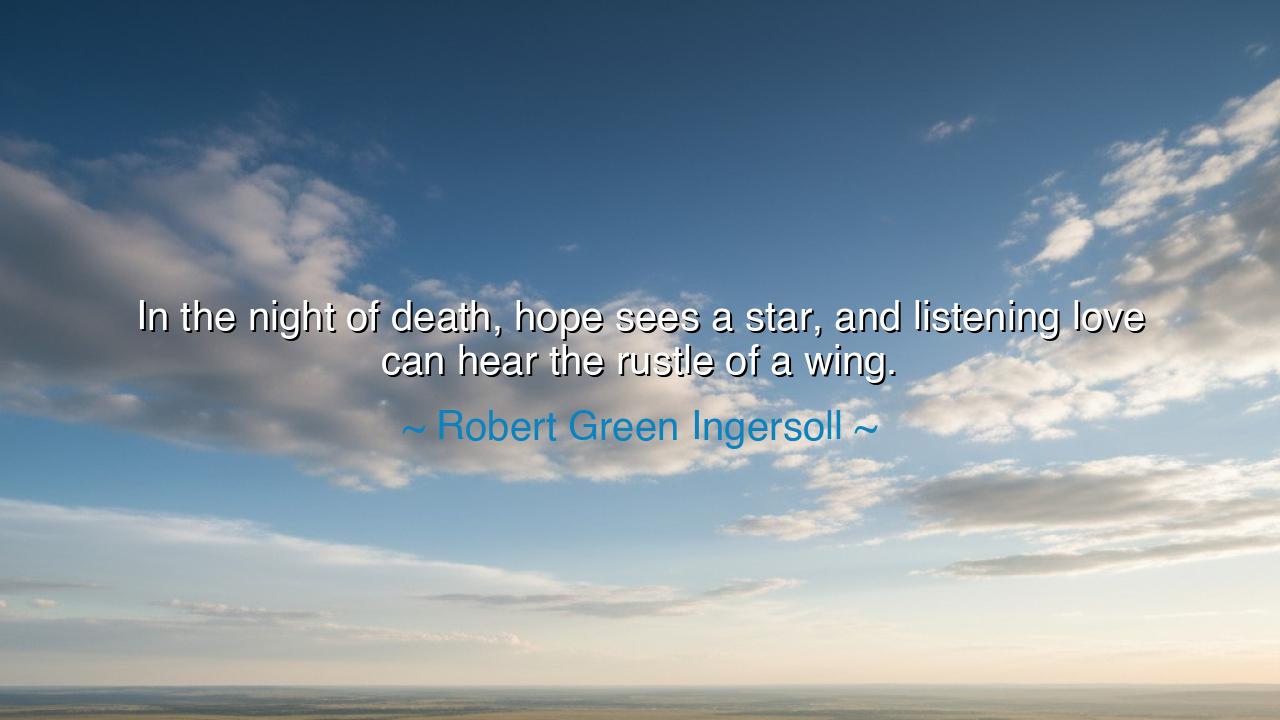
In the night of death, hope sees a star, and listening love can
In the night of death, hope sees a star, and listening love can hear the rustle of a wing.






“In the night of death, hope sees a star, and listening love can hear the rustle of a wing.” — Robert Green Ingersoll
In this radiant and tender phrase, Robert Green Ingersoll, known as “The Great Agnostic,” speaks not as a skeptic, but as a poet of the human spirit. Though he was a man of reason and free thought, in this line he reaches beyond philosophy and touches the divine in human feeling. When he writes, “In the night of death,” he invokes the deepest shadow that falls upon the soul — the darkness of loss, the silence that follows the final breath. Yet even there, he says, “hope sees a star.” This is not the hope of doctrine, but the eternal light within the heart — the faith that love endures, that something beautiful whispers even in endings. Ingersoll’s words remind us that in grief, when all seems still, the human spirit can yet perceive signs of meaning, faint but eternal, like a star trembling in the night.
To understand these words, we must remember the man who spoke them. Robert Ingersoll lived in the nineteenth century, an age of both faith and doubt, when science had begun to question the heavens but had not yet replaced their comfort. A lawyer, soldier, and orator, he rejected the dogmas of organized religion, yet never mocked the emotions that gave them birth. He did not believe in the immortality of the soul as religion taught, but he believed in the immortality of love — that what is good and kind in us echoes onward, unseen but unforgotten. His quote reflects that conviction: that when death arrives, love does not fall silent, but continues to hum in the air, like the faint rustle of a wing — the unseen flutter of something divine, still near.
The ancients would have called such a thought the triumph of the spirit over darkness. In every culture, from Egypt to Greece, from the tribes of the desert to the poets of the East, humanity has imagined light piercing the shadow of death — the flame that endures when all else is consumed. Ingersoll’s “star” is the same eternal symbol: the light of memory, the spark of faith, the glimmer of meaning that shines through grief. And the “rustle of a wing” — that delicate sound — is the whisper of the unseen: the suggestion that love, though invisible, is real, and that those we have lost are not gone, but changed, transformed into something that moves softly at the edge of our senses.
There is a story that mirrors this truth — the story of Helen Keller, who, though blind and deaf from infancy, lived a life of courage and wonder. When her beloved teacher, Anne Sullivan, died, Keller wrote that she could still feel her presence in the quiet of her mind, as though “the air itself remembered her touch.” That is the rustle of the wing that Ingersoll spoke of — the tender proof that love transcends the boundaries of death and the senses alike. Hope sees the star; love hears the wing. Even when the world turns dark, the heart that listens can perceive what the eyes cannot.
Ingersoll’s message is not one of religion, but of reverence — reverence for the power of the human heart. His “night of death” is not only the passing of a person but also the moments in life when we face despair, loss, and endings of every kind. In such nights, hope and love are the two lanterns that never truly go out. Hope looks upward, seeing beyond the horizon of sorrow, while love listens inward, hearing the quiet persistence of what remains. These are not fragile emotions but enduring forces — the twin wings of the soul that carry humanity through its darkest hours.
Thus, this quote becomes not only a meditation on death but a guide for life. To live as Ingersoll teaches is to cultivate the vision of hope and the ear of love. It is to look for light even when all seems lost, and to listen for meaning in the silences that follow pain. The star may not end the night, but it gives it direction; the wing may not lift us at once, but it reminds us that something still moves, still breathes, still carries us forward. The wise know that grief is not the absence of love, but its transformation — that what once touched the body now touches the soul.
Lesson:
In the end, Robert Green Ingersoll offers a sacred truth for every generation: that love and hope are stronger than death, not because they defy it, but because they illuminate it. When you stand in the night of loss, lift your eyes and seek your star — the memory that shines, the promise that life still has beauty. And when you grow still, listen for the rustle of the wing — the sound of love that has changed its form but not its essence. Let your grief not harden, but awaken tenderness. For though death is certain, despair is not. The light remains; the wing still moves; and through them both, the eternal heart of life continues to beat.






AAdministratorAdministrator
Welcome, honored guests. Please leave a comment, we will respond soon